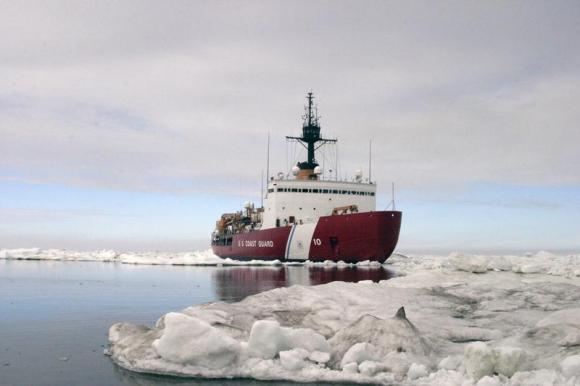Expanding Arctic ocean to get its own shipping rules
Date: 22-Jan-14
Country: NORWAY
Author: Balazs Koranyi

Polar Star, the U.S. Coast Guard icebreaker, completes ice drills in
the Arctic in this July 3, 2013 handout photo.
Photo: U.S. Coast Guard
New shipping rules are soon to be agreed for the Arctic, where summer sea ice has shrunk by about two-thirds over three decades, opening a new ocean with vast natural resources.
Maritime nations are close to a landmark deal on the Polar Code, aimed to improve safety, lead to lower insurance premiums and help the rise of traffic, industry insiders said.
About a tenth of the world's undiscovered oil and close to a third of its undiscovered gas is thought to lie under Arctic waters. The Northern Sea Route along Russia's edge can reduce the sailing distance between Asian ports and Northern Europe by 40 percent.
A draft of the code could be finalized by members of the International Maritime Organization (IMO) this week and go into force by 2016, ending years of delays, Sturla Henriksen, the director general of Norwegian Shipowners' Association said.
"There are no international conventions which regulate Arctic shipping operations, so in principle the same rules apply for sunny sailing in the Mediterranean as for the Arctic," Henriksen told Reuters on the sidelines of a conference.
"It's a cold place, it has a hostile climate, it's enshrouded in darkness half of the year, weather is violent and extreme, distances are vast, the area is remote from large population centers, it's sparsely populated and it's far from basic infrastructure," Henriksen added.
Only 71 ships crossed the Northern Sea Route last year, compared to the 18,000 handled by the Suez Canal, but about a 1,000 vessels travelled into the high Arctic, with much of the growth coming from oil and gas activity, particularly in Russia.
The Polar Code will set stringent rules on pollution, safety of life, training, certification and watch keeping. It will prescribe ship properties including required ice class and set uniform rules for all vessels in all of the polar countries.
Under the current rules, any vessel travelling into the high Arctic - defined as above 72 degrees north - had to agree on a separate policy with its insurer with unique conditions negotiated for each vessel and each journey.
"The Polar Code is a very good step forward, we endorse it but it is just a step forward, we can't stop now," said Stein Are Hansen, the Assistant Director of the Norwegian Hull Club, a mutual marine insurance firm.
"Any risk mitigation measures that produce fewer insurance claims will of course on average make insurance prices go down," Hansen said, adding that better search and rescue, improved maps and more icebreakers were still needed.
If the draft is approved this week, it could get a final approval before the end of the year and go into force 18 to 24 months later.
The code does not deal with the problem of ballast water discharge, which often introduces non native species to a region, and continues to allow vessels to use heavy fuel oil, a risk as the fuel would contaminate waters in case of an accident.
"We are concerned that there are important aspects that the Polar Code doesn't address," Nina Jensen, the head of environmental group WWF's Norwegian branch said.
(Editing by William Hardy)
![]()
© Thomson Reuters 2014 All rights reserved